Hospitality Industry Marketing Strategies
VerifiedAdded on 2020/02/24
|11
|2729
|74
AI Summary
This assignment delves into the diverse marketing strategies employed within the hospitality industry. It examines the impact of global trends on company retreats, challenges in hospitality hiring, and successful brand building examples like Starbucks. The analysis also covers the influence of online reviews, customer perceived value, and the role of physical environment, food, and service quality on restaurant image and customer behavior.
Contribute Materials
Your contribution can guide someone’s learning journey. Share your
documents today.
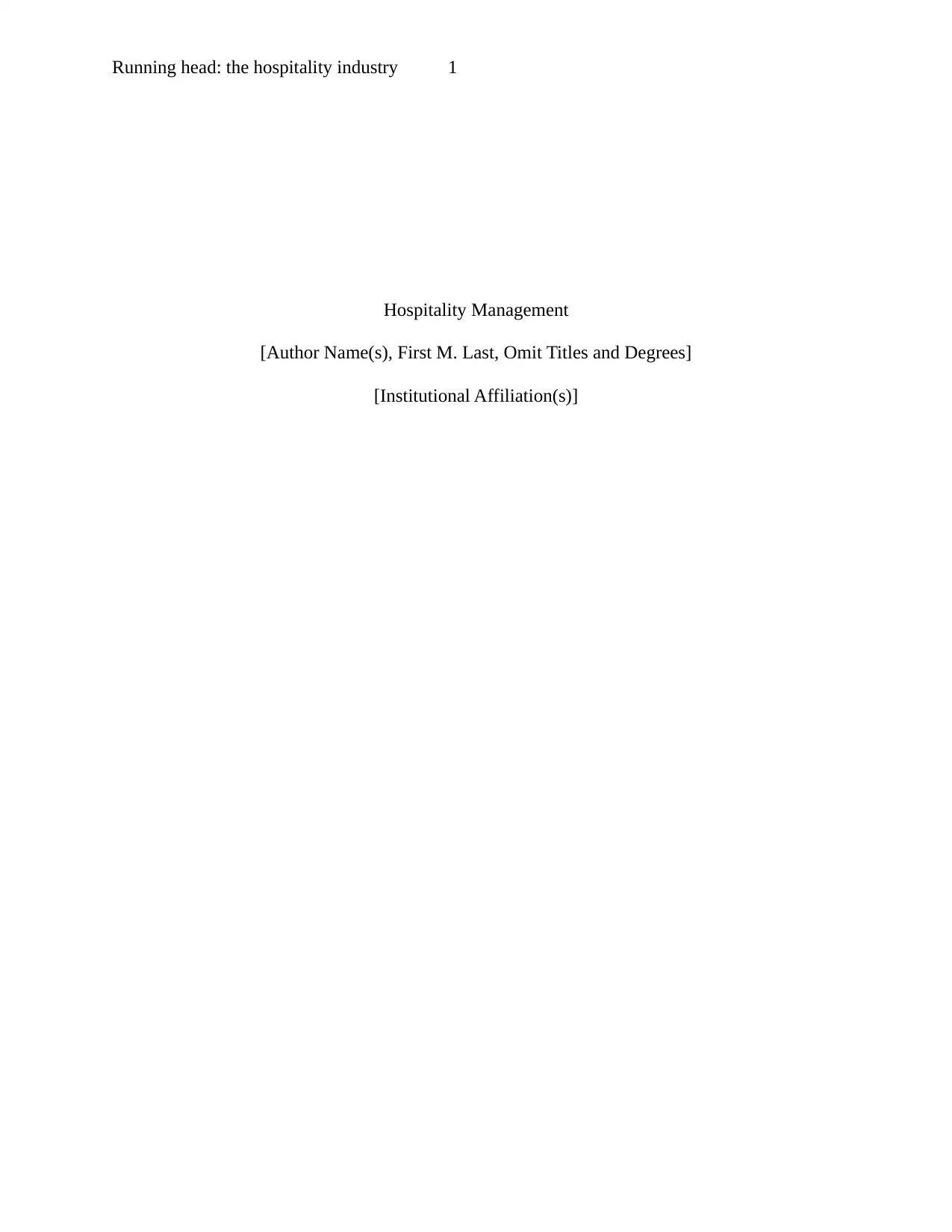
Running head: the hospitality industry 1
Hospitality Management
[Author Name(s), First M. Last, Omit Titles and Degrees]
[Institutional Affiliation(s)]
Hospitality Management
[Author Name(s), First M. Last, Omit Titles and Degrees]
[Institutional Affiliation(s)]
Secure Best Marks with AI Grader
Need help grading? Try our AI Grader for instant feedback on your assignments.
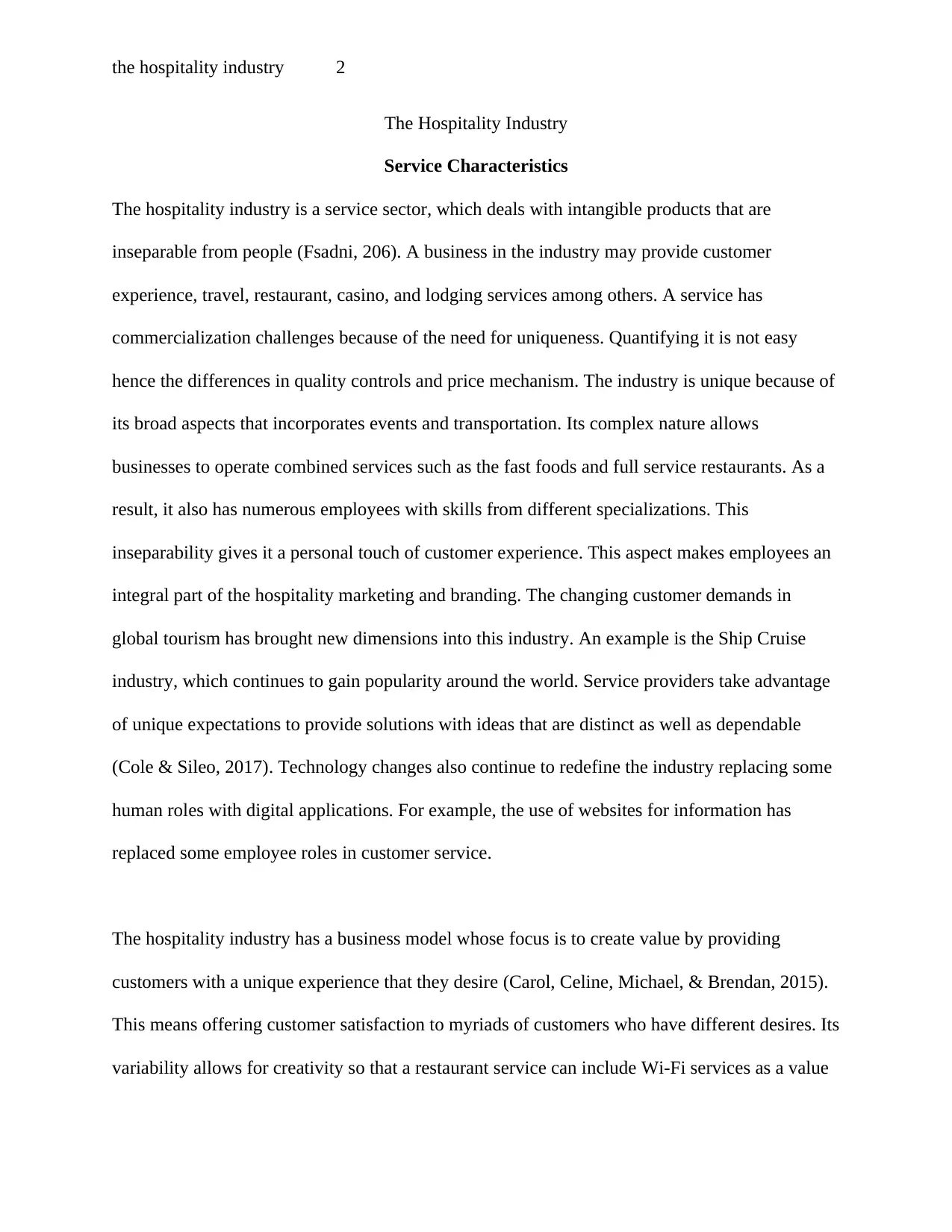
the hospitality industry 2
The Hospitality Industry
Service Characteristics
The hospitality industry is a service sector, which deals with intangible products that are
inseparable from people (Fsadni, 206). A business in the industry may provide customer
experience, travel, restaurant, casino, and lodging services among others. A service has
commercialization challenges because of the need for uniqueness. Quantifying it is not easy
hence the differences in quality controls and price mechanism. The industry is unique because of
its broad aspects that incorporates events and transportation. Its complex nature allows
businesses to operate combined services such as the fast foods and full service restaurants. As a
result, it also has numerous employees with skills from different specializations. This
inseparability gives it a personal touch of customer experience. This aspect makes employees an
integral part of the hospitality marketing and branding. The changing customer demands in
global tourism has brought new dimensions into this industry. An example is the Ship Cruise
industry, which continues to gain popularity around the world. Service providers take advantage
of unique expectations to provide solutions with ideas that are distinct as well as dependable
(Cole & Sileo, 2017). Technology changes also continue to redefine the industry replacing some
human roles with digital applications. For example, the use of websites for information has
replaced some employee roles in customer service.
The hospitality industry has a business model whose focus is to create value by providing
customers with a unique experience that they desire (Carol, Celine, Michael, & Brendan, 2015).
This means offering customer satisfaction to myriads of customers who have different desires. Its
variability allows for creativity so that a restaurant service can include Wi-Fi services as a value
The Hospitality Industry
Service Characteristics
The hospitality industry is a service sector, which deals with intangible products that are
inseparable from people (Fsadni, 206). A business in the industry may provide customer
experience, travel, restaurant, casino, and lodging services among others. A service has
commercialization challenges because of the need for uniqueness. Quantifying it is not easy
hence the differences in quality controls and price mechanism. The industry is unique because of
its broad aspects that incorporates events and transportation. Its complex nature allows
businesses to operate combined services such as the fast foods and full service restaurants. As a
result, it also has numerous employees with skills from different specializations. This
inseparability gives it a personal touch of customer experience. This aspect makes employees an
integral part of the hospitality marketing and branding. The changing customer demands in
global tourism has brought new dimensions into this industry. An example is the Ship Cruise
industry, which continues to gain popularity around the world. Service providers take advantage
of unique expectations to provide solutions with ideas that are distinct as well as dependable
(Cole & Sileo, 2017). Technology changes also continue to redefine the industry replacing some
human roles with digital applications. For example, the use of websites for information has
replaced some employee roles in customer service.
The hospitality industry has a business model whose focus is to create value by providing
customers with a unique experience that they desire (Carol, Celine, Michael, & Brendan, 2015).
This means offering customer satisfaction to myriads of customers who have different desires. Its
variability allows for creativity so that a restaurant service can include Wi-Fi services as a value
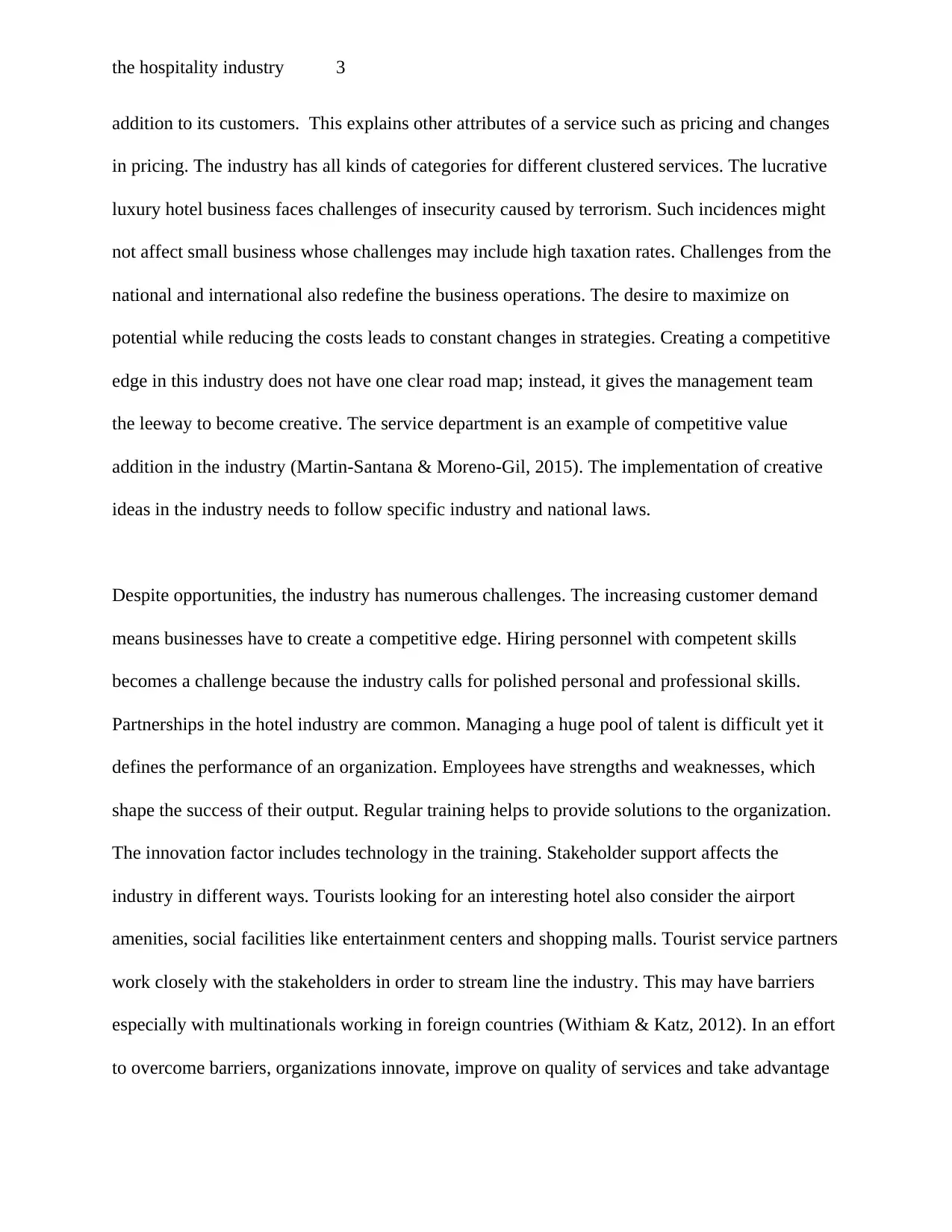
the hospitality industry 3
addition to its customers. This explains other attributes of a service such as pricing and changes
in pricing. The industry has all kinds of categories for different clustered services. The lucrative
luxury hotel business faces challenges of insecurity caused by terrorism. Such incidences might
not affect small business whose challenges may include high taxation rates. Challenges from the
national and international also redefine the business operations. The desire to maximize on
potential while reducing the costs leads to constant changes in strategies. Creating a competitive
edge in this industry does not have one clear road map; instead, it gives the management team
the leeway to become creative. The service department is an example of competitive value
addition in the industry (Martin-Santana & Moreno-Gil, 2015). The implementation of creative
ideas in the industry needs to follow specific industry and national laws.
Despite opportunities, the industry has numerous challenges. The increasing customer demand
means businesses have to create a competitive edge. Hiring personnel with competent skills
becomes a challenge because the industry calls for polished personal and professional skills.
Partnerships in the hotel industry are common. Managing a huge pool of talent is difficult yet it
defines the performance of an organization. Employees have strengths and weaknesses, which
shape the success of their output. Regular training helps to provide solutions to the organization.
The innovation factor includes technology in the training. Stakeholder support affects the
industry in different ways. Tourists looking for an interesting hotel also consider the airport
amenities, social facilities like entertainment centers and shopping malls. Tourist service partners
work closely with the stakeholders in order to stream line the industry. This may have barriers
especially with multinationals working in foreign countries (Withiam & Katz, 2012). In an effort
to overcome barriers, organizations innovate, improve on quality of services and take advantage
addition to its customers. This explains other attributes of a service such as pricing and changes
in pricing. The industry has all kinds of categories for different clustered services. The lucrative
luxury hotel business faces challenges of insecurity caused by terrorism. Such incidences might
not affect small business whose challenges may include high taxation rates. Challenges from the
national and international also redefine the business operations. The desire to maximize on
potential while reducing the costs leads to constant changes in strategies. Creating a competitive
edge in this industry does not have one clear road map; instead, it gives the management team
the leeway to become creative. The service department is an example of competitive value
addition in the industry (Martin-Santana & Moreno-Gil, 2015). The implementation of creative
ideas in the industry needs to follow specific industry and national laws.
Despite opportunities, the industry has numerous challenges. The increasing customer demand
means businesses have to create a competitive edge. Hiring personnel with competent skills
becomes a challenge because the industry calls for polished personal and professional skills.
Partnerships in the hotel industry are common. Managing a huge pool of talent is difficult yet it
defines the performance of an organization. Employees have strengths and weaknesses, which
shape the success of their output. Regular training helps to provide solutions to the organization.
The innovation factor includes technology in the training. Stakeholder support affects the
industry in different ways. Tourists looking for an interesting hotel also consider the airport
amenities, social facilities like entertainment centers and shopping malls. Tourist service partners
work closely with the stakeholders in order to stream line the industry. This may have barriers
especially with multinationals working in foreign countries (Withiam & Katz, 2012). In an effort
to overcome barriers, organizations innovate, improve on quality of services and take advantage
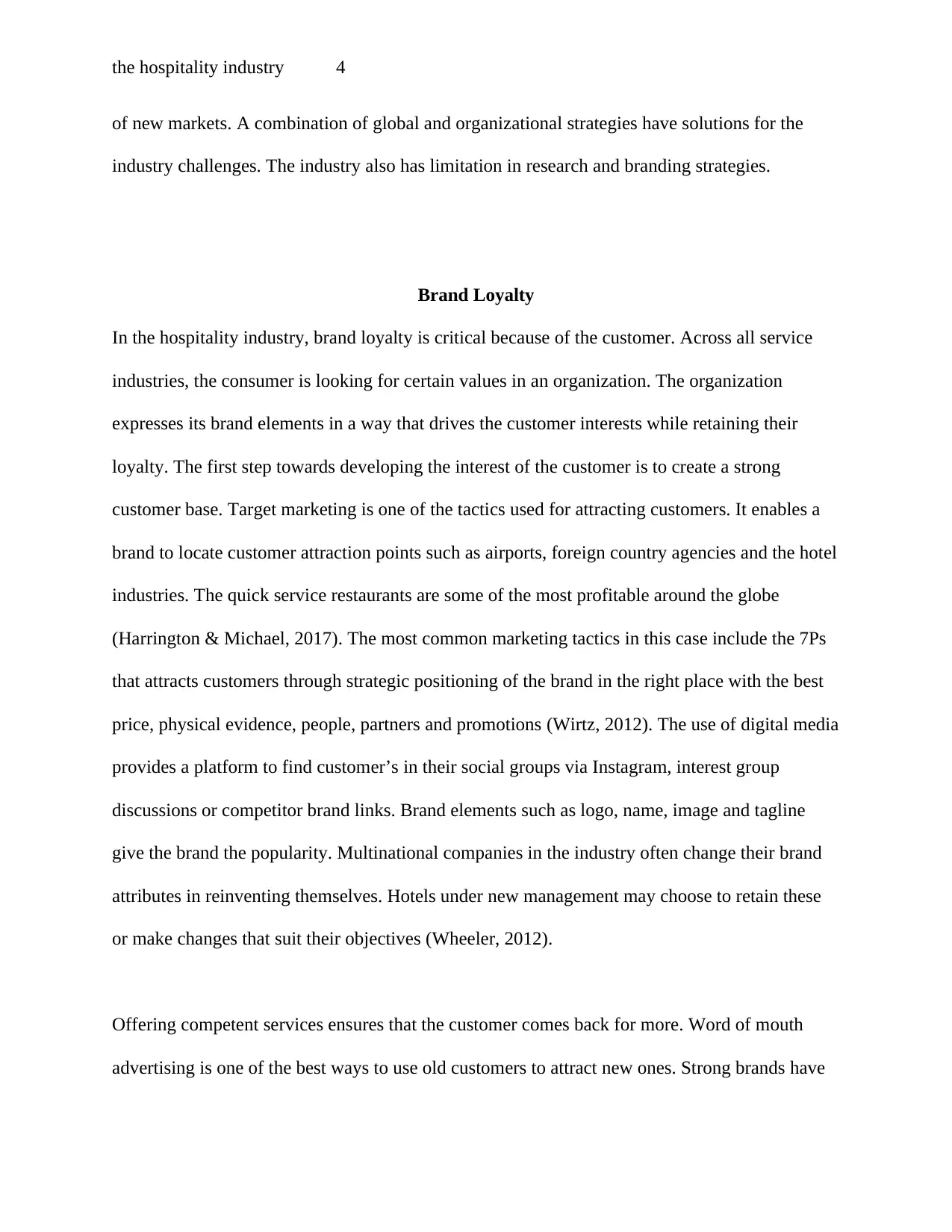
the hospitality industry 4
of new markets. A combination of global and organizational strategies have solutions for the
industry challenges. The industry also has limitation in research and branding strategies.
Brand Loyalty
In the hospitality industry, brand loyalty is critical because of the customer. Across all service
industries, the consumer is looking for certain values in an organization. The organization
expresses its brand elements in a way that drives the customer interests while retaining their
loyalty. The first step towards developing the interest of the customer is to create a strong
customer base. Target marketing is one of the tactics used for attracting customers. It enables a
brand to locate customer attraction points such as airports, foreign country agencies and the hotel
industries. The quick service restaurants are some of the most profitable around the globe
(Harrington & Michael, 2017). The most common marketing tactics in this case include the 7Ps
that attracts customers through strategic positioning of the brand in the right place with the best
price, physical evidence, people, partners and promotions (Wirtz, 2012). The use of digital media
provides a platform to find customer’s in their social groups via Instagram, interest group
discussions or competitor brand links. Brand elements such as logo, name, image and tagline
give the brand the popularity. Multinational companies in the industry often change their brand
attributes in reinventing themselves. Hotels under new management may choose to retain these
or make changes that suit their objectives (Wheeler, 2012).
Offering competent services ensures that the customer comes back for more. Word of mouth
advertising is one of the best ways to use old customers to attract new ones. Strong brands have
of new markets. A combination of global and organizational strategies have solutions for the
industry challenges. The industry also has limitation in research and branding strategies.
Brand Loyalty
In the hospitality industry, brand loyalty is critical because of the customer. Across all service
industries, the consumer is looking for certain values in an organization. The organization
expresses its brand elements in a way that drives the customer interests while retaining their
loyalty. The first step towards developing the interest of the customer is to create a strong
customer base. Target marketing is one of the tactics used for attracting customers. It enables a
brand to locate customer attraction points such as airports, foreign country agencies and the hotel
industries. The quick service restaurants are some of the most profitable around the globe
(Harrington & Michael, 2017). The most common marketing tactics in this case include the 7Ps
that attracts customers through strategic positioning of the brand in the right place with the best
price, physical evidence, people, partners and promotions (Wirtz, 2012). The use of digital media
provides a platform to find customer’s in their social groups via Instagram, interest group
discussions or competitor brand links. Brand elements such as logo, name, image and tagline
give the brand the popularity. Multinational companies in the industry often change their brand
attributes in reinventing themselves. Hotels under new management may choose to retain these
or make changes that suit their objectives (Wheeler, 2012).
Offering competent services ensures that the customer comes back for more. Word of mouth
advertising is one of the best ways to use old customers to attract new ones. Strong brands have
Secure Best Marks with AI Grader
Need help grading? Try our AI Grader for instant feedback on your assignments.
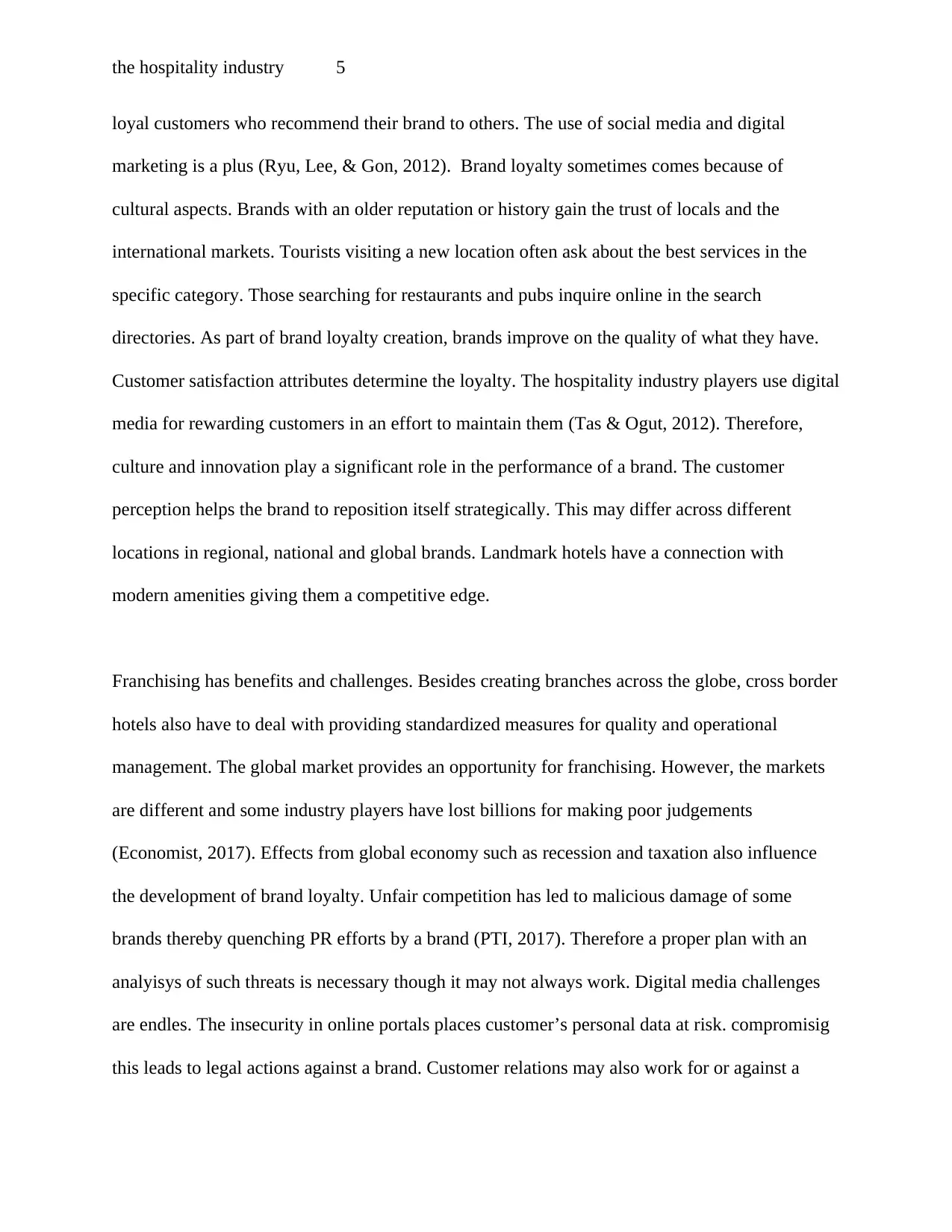
the hospitality industry 5
loyal customers who recommend their brand to others. The use of social media and digital
marketing is a plus (Ryu, Lee, & Gon, 2012). Brand loyalty sometimes comes because of
cultural aspects. Brands with an older reputation or history gain the trust of locals and the
international markets. Tourists visiting a new location often ask about the best services in the
specific category. Those searching for restaurants and pubs inquire online in the search
directories. As part of brand loyalty creation, brands improve on the quality of what they have.
Customer satisfaction attributes determine the loyalty. The hospitality industry players use digital
media for rewarding customers in an effort to maintain them (Tas & Ogut, 2012). Therefore,
culture and innovation play a significant role in the performance of a brand. The customer
perception helps the brand to reposition itself strategically. This may differ across different
locations in regional, national and global brands. Landmark hotels have a connection with
modern amenities giving them a competitive edge.
Franchising has benefits and challenges. Besides creating branches across the globe, cross border
hotels also have to deal with providing standardized measures for quality and operational
management. The global market provides an opportunity for franchising. However, the markets
are different and some industry players have lost billions for making poor judgements
(Economist, 2017). Effects from global economy such as recession and taxation also influence
the development of brand loyalty. Unfair competition has led to malicious damage of some
brands thereby quenching PR efforts by a brand (PTI, 2017). Therefore a proper plan with an
analyisys of such threats is necessary though it may not always work. Digital media challenges
are endles. The insecurity in online portals places customer’s personal data at risk. compromisig
this leads to legal actions against a brand. Customer relations may also work for or against a
loyal customers who recommend their brand to others. The use of social media and digital
marketing is a plus (Ryu, Lee, & Gon, 2012). Brand loyalty sometimes comes because of
cultural aspects. Brands with an older reputation or history gain the trust of locals and the
international markets. Tourists visiting a new location often ask about the best services in the
specific category. Those searching for restaurants and pubs inquire online in the search
directories. As part of brand loyalty creation, brands improve on the quality of what they have.
Customer satisfaction attributes determine the loyalty. The hospitality industry players use digital
media for rewarding customers in an effort to maintain them (Tas & Ogut, 2012). Therefore,
culture and innovation play a significant role in the performance of a brand. The customer
perception helps the brand to reposition itself strategically. This may differ across different
locations in regional, national and global brands. Landmark hotels have a connection with
modern amenities giving them a competitive edge.
Franchising has benefits and challenges. Besides creating branches across the globe, cross border
hotels also have to deal with providing standardized measures for quality and operational
management. The global market provides an opportunity for franchising. However, the markets
are different and some industry players have lost billions for making poor judgements
(Economist, 2017). Effects from global economy such as recession and taxation also influence
the development of brand loyalty. Unfair competition has led to malicious damage of some
brands thereby quenching PR efforts by a brand (PTI, 2017). Therefore a proper plan with an
analyisys of such threats is necessary though it may not always work. Digital media challenges
are endles. The insecurity in online portals places customer’s personal data at risk. compromisig
this leads to legal actions against a brand. Customer relations may also work for or against a
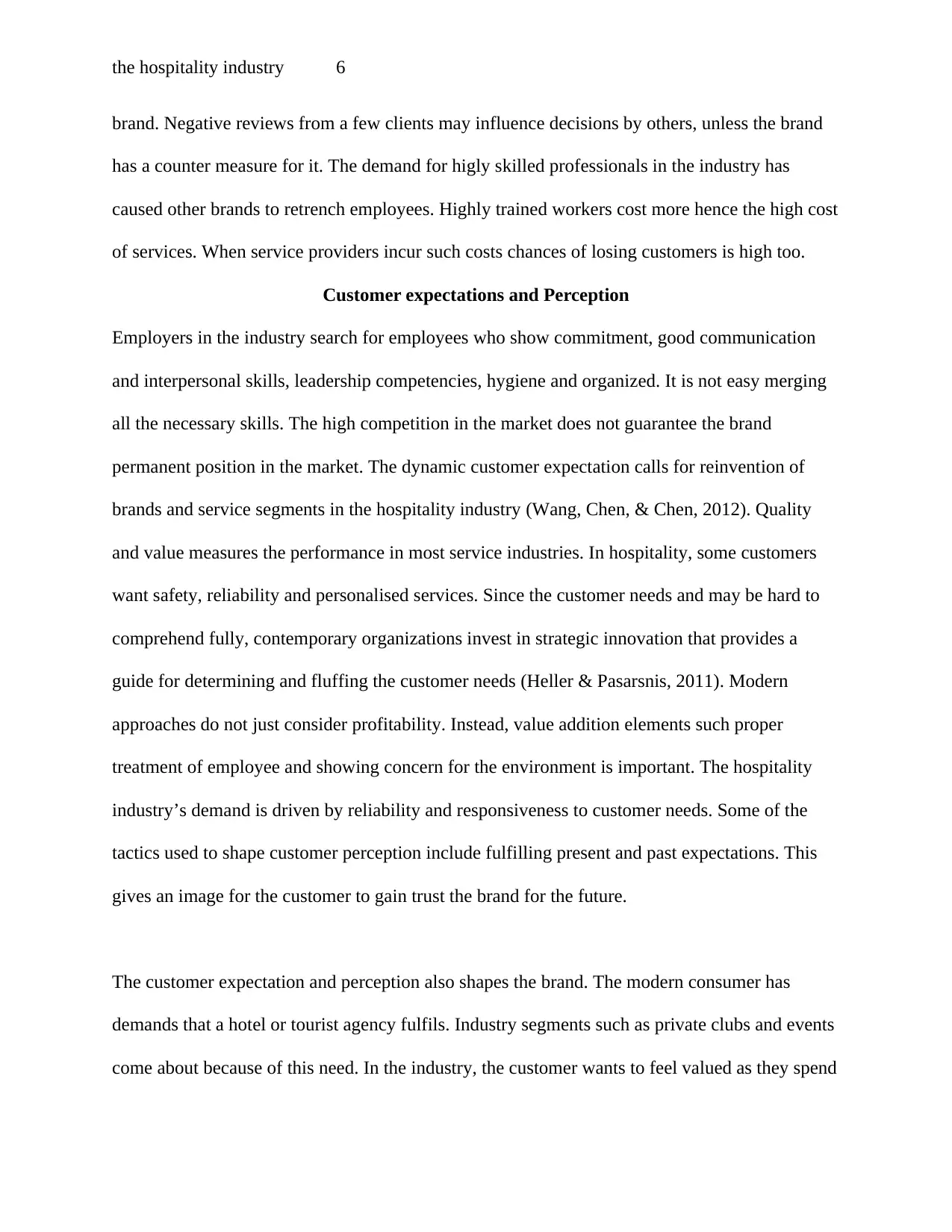
the hospitality industry 6
brand. Negative reviews from a few clients may influence decisions by others, unless the brand
has a counter measure for it. The demand for higly skilled professionals in the industry has
caused other brands to retrench employees. Highly trained workers cost more hence the high cost
of services. When service providers incur such costs chances of losing customers is high too.
Customer expectations and Perception
Employers in the industry search for employees who show commitment, good communication
and interpersonal skills, leadership competencies, hygiene and organized. It is not easy merging
all the necessary skills. The high competition in the market does not guarantee the brand
permanent position in the market. The dynamic customer expectation calls for reinvention of
brands and service segments in the hospitality industry (Wang, Chen, & Chen, 2012). Quality
and value measures the performance in most service industries. In hospitality, some customers
want safety, reliability and personalised services. Since the customer needs and may be hard to
comprehend fully, contemporary organizations invest in strategic innovation that provides a
guide for determining and fluffing the customer needs (Heller & Pasarsnis, 2011). Modern
approaches do not just consider profitability. Instead, value addition elements such proper
treatment of employee and showing concern for the environment is important. The hospitality
industry’s demand is driven by reliability and responsiveness to customer needs. Some of the
tactics used to shape customer perception include fulfilling present and past expectations. This
gives an image for the customer to gain trust the brand for the future.
The customer expectation and perception also shapes the brand. The modern consumer has
demands that a hotel or tourist agency fulfils. Industry segments such as private clubs and events
come about because of this need. In the industry, the customer wants to feel valued as they spend
brand. Negative reviews from a few clients may influence decisions by others, unless the brand
has a counter measure for it. The demand for higly skilled professionals in the industry has
caused other brands to retrench employees. Highly trained workers cost more hence the high cost
of services. When service providers incur such costs chances of losing customers is high too.
Customer expectations and Perception
Employers in the industry search for employees who show commitment, good communication
and interpersonal skills, leadership competencies, hygiene and organized. It is not easy merging
all the necessary skills. The high competition in the market does not guarantee the brand
permanent position in the market. The dynamic customer expectation calls for reinvention of
brands and service segments in the hospitality industry (Wang, Chen, & Chen, 2012). Quality
and value measures the performance in most service industries. In hospitality, some customers
want safety, reliability and personalised services. Since the customer needs and may be hard to
comprehend fully, contemporary organizations invest in strategic innovation that provides a
guide for determining and fluffing the customer needs (Heller & Pasarsnis, 2011). Modern
approaches do not just consider profitability. Instead, value addition elements such proper
treatment of employee and showing concern for the environment is important. The hospitality
industry’s demand is driven by reliability and responsiveness to customer needs. Some of the
tactics used to shape customer perception include fulfilling present and past expectations. This
gives an image for the customer to gain trust the brand for the future.
The customer expectation and perception also shapes the brand. The modern consumer has
demands that a hotel or tourist agency fulfils. Industry segments such as private clubs and events
come about because of this need. In the industry, the customer wants to feel valued as they spend
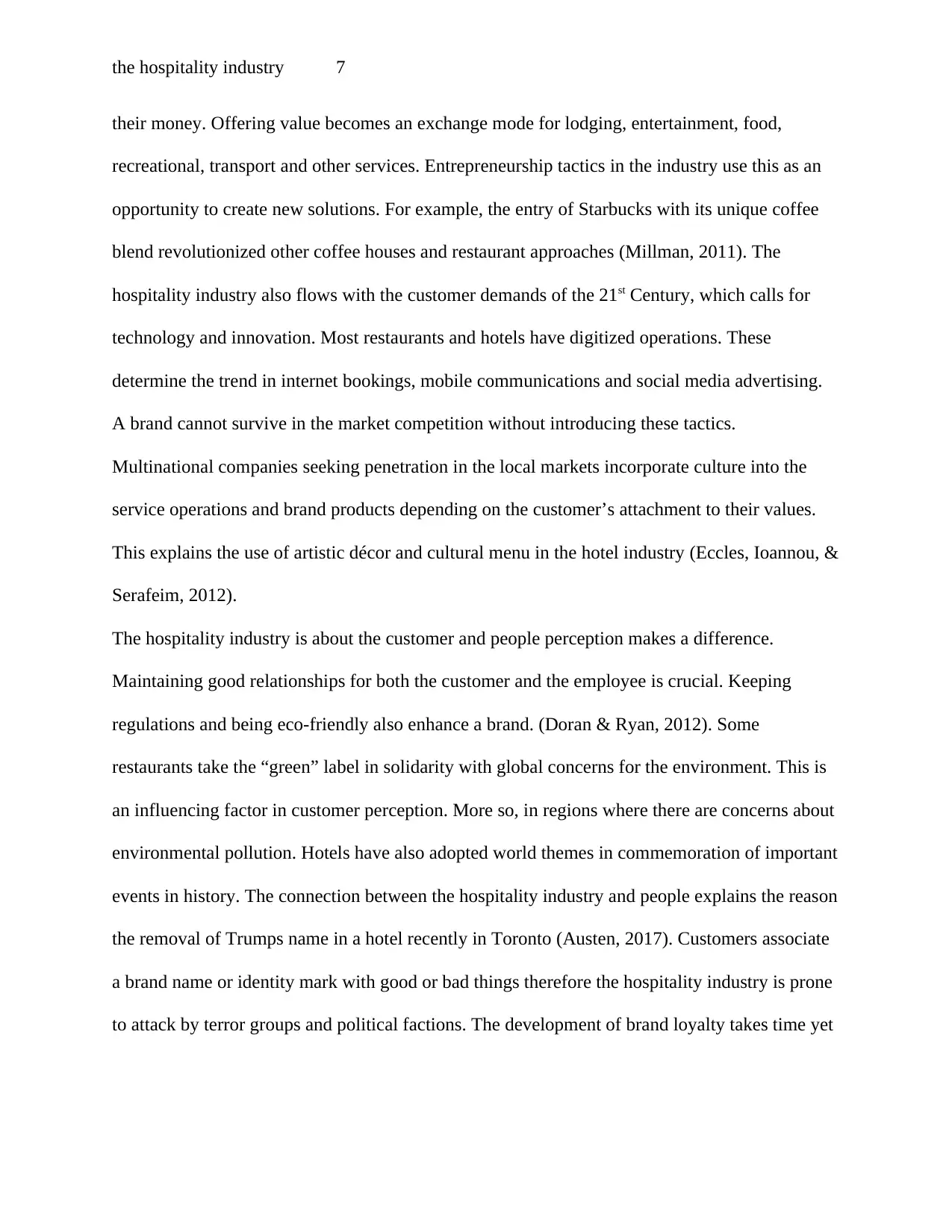
the hospitality industry 7
their money. Offering value becomes an exchange mode for lodging, entertainment, food,
recreational, transport and other services. Entrepreneurship tactics in the industry use this as an
opportunity to create new solutions. For example, the entry of Starbucks with its unique coffee
blend revolutionized other coffee houses and restaurant approaches (Millman, 2011). The
hospitality industry also flows with the customer demands of the 21st Century, which calls for
technology and innovation. Most restaurants and hotels have digitized operations. These
determine the trend in internet bookings, mobile communications and social media advertising.
A brand cannot survive in the market competition without introducing these tactics.
Multinational companies seeking penetration in the local markets incorporate culture into the
service operations and brand products depending on the customer’s attachment to their values.
This explains the use of artistic décor and cultural menu in the hotel industry (Eccles, Ioannou, &
Serafeim, 2012).
The hospitality industry is about the customer and people perception makes a difference.
Maintaining good relationships for both the customer and the employee is crucial. Keeping
regulations and being eco-friendly also enhance a brand. (Doran & Ryan, 2012). Some
restaurants take the “green” label in solidarity with global concerns for the environment. This is
an influencing factor in customer perception. More so, in regions where there are concerns about
environmental pollution. Hotels have also adopted world themes in commemoration of important
events in history. The connection between the hospitality industry and people explains the reason
the removal of Trumps name in a hotel recently in Toronto (Austen, 2017). Customers associate
a brand name or identity mark with good or bad things therefore the hospitality industry is prone
to attack by terror groups and political factions. The development of brand loyalty takes time yet
their money. Offering value becomes an exchange mode for lodging, entertainment, food,
recreational, transport and other services. Entrepreneurship tactics in the industry use this as an
opportunity to create new solutions. For example, the entry of Starbucks with its unique coffee
blend revolutionized other coffee houses and restaurant approaches (Millman, 2011). The
hospitality industry also flows with the customer demands of the 21st Century, which calls for
technology and innovation. Most restaurants and hotels have digitized operations. These
determine the trend in internet bookings, mobile communications and social media advertising.
A brand cannot survive in the market competition without introducing these tactics.
Multinational companies seeking penetration in the local markets incorporate culture into the
service operations and brand products depending on the customer’s attachment to their values.
This explains the use of artistic décor and cultural menu in the hotel industry (Eccles, Ioannou, &
Serafeim, 2012).
The hospitality industry is about the customer and people perception makes a difference.
Maintaining good relationships for both the customer and the employee is crucial. Keeping
regulations and being eco-friendly also enhance a brand. (Doran & Ryan, 2012). Some
restaurants take the “green” label in solidarity with global concerns for the environment. This is
an influencing factor in customer perception. More so, in regions where there are concerns about
environmental pollution. Hotels have also adopted world themes in commemoration of important
events in history. The connection between the hospitality industry and people explains the reason
the removal of Trumps name in a hotel recently in Toronto (Austen, 2017). Customers associate
a brand name or identity mark with good or bad things therefore the hospitality industry is prone
to attack by terror groups and political factions. The development of brand loyalty takes time yet
Paraphrase This Document
Need a fresh take? Get an instant paraphrase of this document with our AI Paraphraser
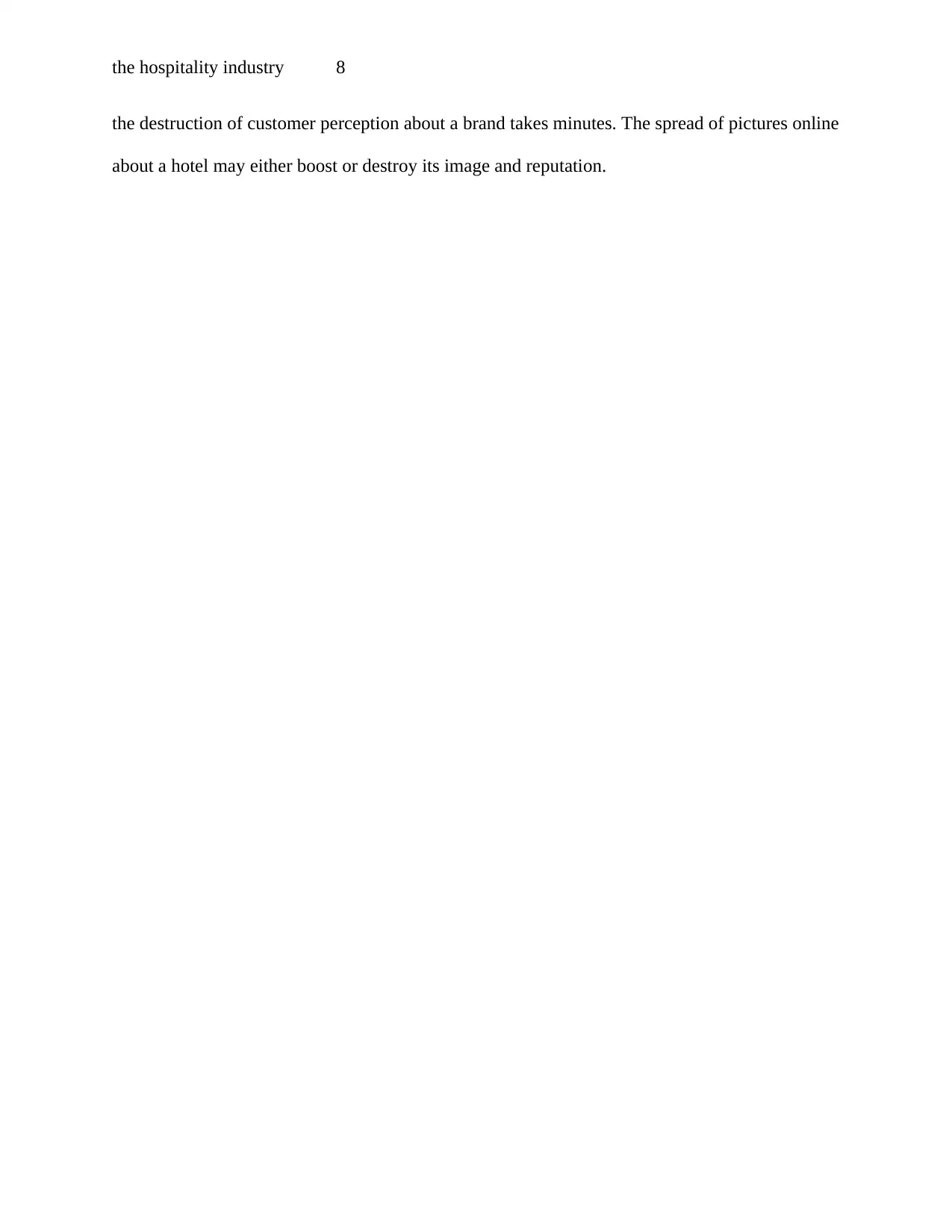
the hospitality industry 8
the destruction of customer perception about a brand takes minutes. The spread of pictures online
about a hotel may either boost or destroy its image and reputation.
the destruction of customer perception about a brand takes minutes. The spread of pictures online
about a hotel may either boost or destroy its image and reputation.
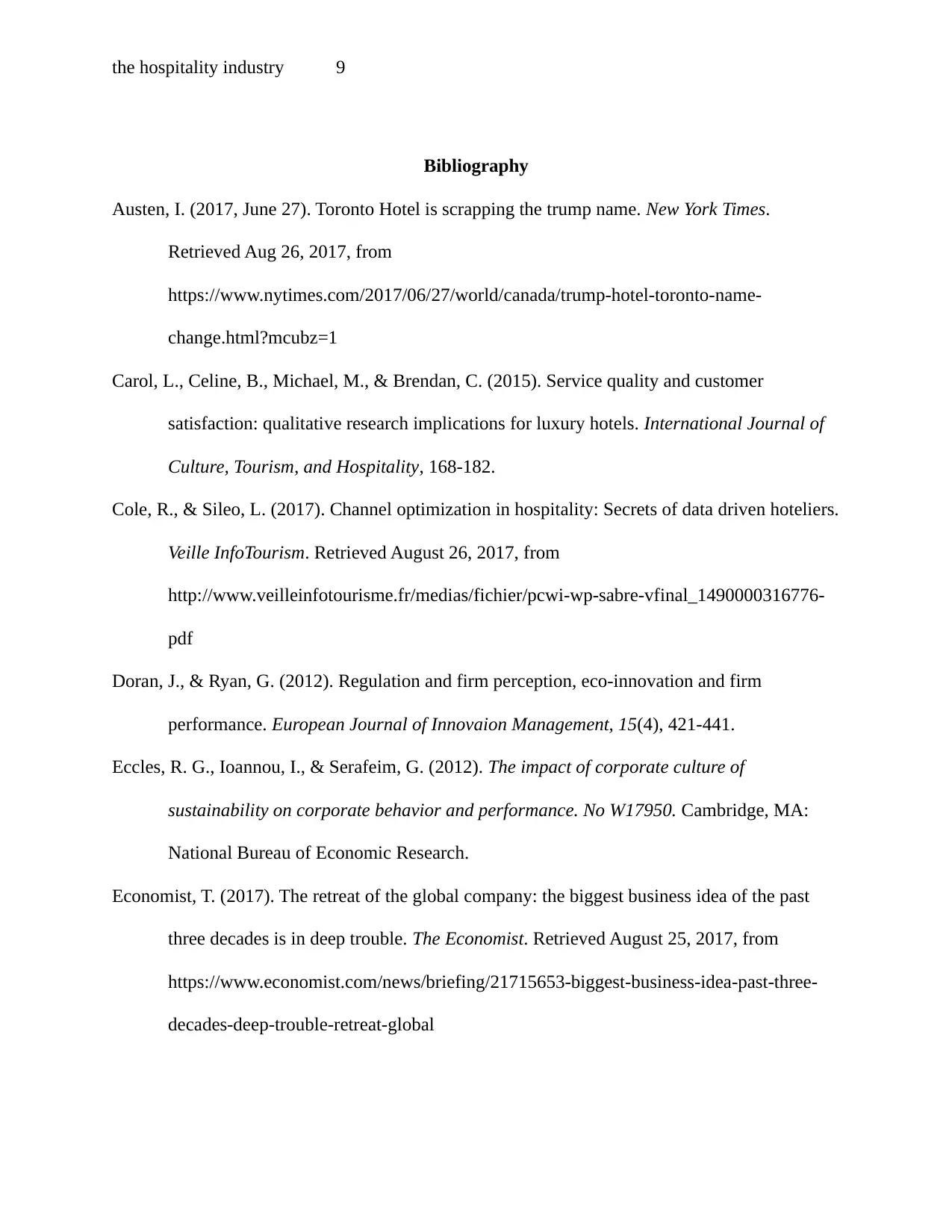
the hospitality industry 9
Bibliography
Austen, I. (2017, June 27). Toronto Hotel is scrapping the trump name. New York Times.
Retrieved Aug 26, 2017, from
https://www.nytimes.com/2017/06/27/world/canada/trump-hotel-toronto-name-
change.html?mcubz=1
Carol, L., Celine, B., Michael, M., & Brendan, C. (2015). Service quality and customer
satisfaction: qualitative research implications for luxury hotels. International Journal of
Culture, Tourism, and Hospitality, 168-182.
Cole, R., & Sileo, L. (2017). Channel optimization in hospitality: Secrets of data driven hoteliers.
Veille InfoTourism. Retrieved August 26, 2017, from
http://www.veilleinfotourisme.fr/medias/fichier/pcwi-wp-sabre-vfinal_1490000316776-
pdf
Doran, J., & Ryan, G. (2012). Regulation and firm perception, eco-innovation and firm
performance. European Journal of Innovaion Management, 15(4), 421-441.
Eccles, R. G., Ioannou, I., & Serafeim, G. (2012). The impact of corporate culture of
sustainability on corporate behavior and performance. No W17950. Cambridge, MA:
National Bureau of Economic Research.
Economist, T. (2017). The retreat of the global company: the biggest business idea of the past
three decades is in deep trouble. The Economist. Retrieved August 25, 2017, from
https://www.economist.com/news/briefing/21715653-biggest-business-idea-past-three-
decades-deep-trouble-retreat-global
Bibliography
Austen, I. (2017, June 27). Toronto Hotel is scrapping the trump name. New York Times.
Retrieved Aug 26, 2017, from
https://www.nytimes.com/2017/06/27/world/canada/trump-hotel-toronto-name-
change.html?mcubz=1
Carol, L., Celine, B., Michael, M., & Brendan, C. (2015). Service quality and customer
satisfaction: qualitative research implications for luxury hotels. International Journal of
Culture, Tourism, and Hospitality, 168-182.
Cole, R., & Sileo, L. (2017). Channel optimization in hospitality: Secrets of data driven hoteliers.
Veille InfoTourism. Retrieved August 26, 2017, from
http://www.veilleinfotourisme.fr/medias/fichier/pcwi-wp-sabre-vfinal_1490000316776-
Doran, J., & Ryan, G. (2012). Regulation and firm perception, eco-innovation and firm
performance. European Journal of Innovaion Management, 15(4), 421-441.
Eccles, R. G., Ioannou, I., & Serafeim, G. (2012). The impact of corporate culture of
sustainability on corporate behavior and performance. No W17950. Cambridge, MA:
National Bureau of Economic Research.
Economist, T. (2017). The retreat of the global company: the biggest business idea of the past
three decades is in deep trouble. The Economist. Retrieved August 25, 2017, from
https://www.economist.com/news/briefing/21715653-biggest-business-idea-past-three-
decades-deep-trouble-retreat-global
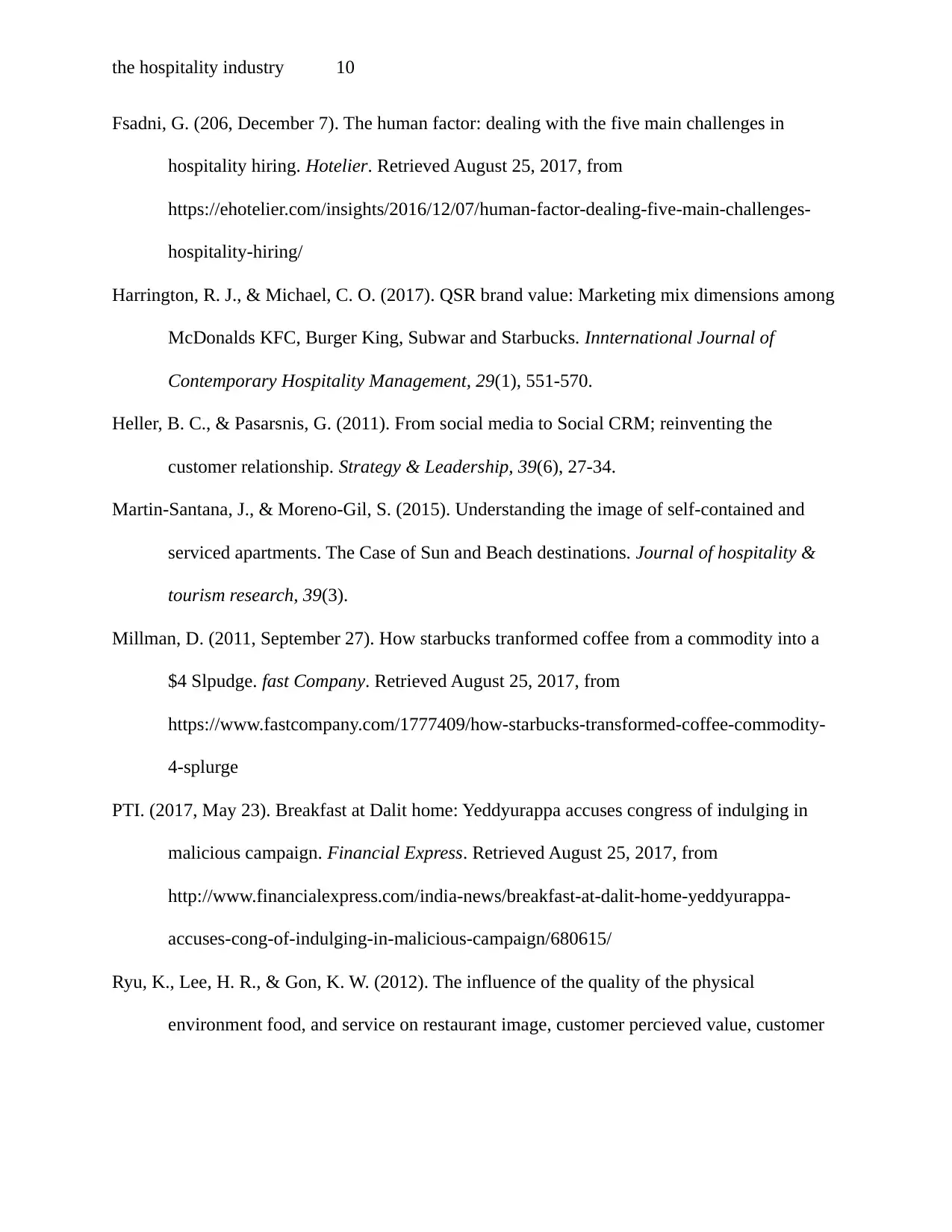
the hospitality industry 10
Fsadni, G. (206, December 7). The human factor: dealing with the five main challenges in
hospitality hiring. Hotelier. Retrieved August 25, 2017, from
https://ehotelier.com/insights/2016/12/07/human-factor-dealing-five-main-challenges-
hospitality-hiring/
Harrington, R. J., & Michael, C. O. (2017). QSR brand value: Marketing mix dimensions among
McDonalds KFC, Burger King, Subwar and Starbucks. Innternational Journal of
Contemporary Hospitality Management, 29(1), 551-570.
Heller, B. C., & Pasarsnis, G. (2011). From social media to Social CRM; reinventing the
customer relationship. Strategy & Leadership, 39(6), 27-34.
Martin-Santana, J., & Moreno-Gil, S. (2015). Understanding the image of self-contained and
serviced apartments. The Case of Sun and Beach destinations. Journal of hospitality &
tourism research, 39(3).
Millman, D. (2011, September 27). How starbucks tranformed coffee from a commodity into a
$4 Slpudge. fast Company. Retrieved August 25, 2017, from
https://www.fastcompany.com/1777409/how-starbucks-transformed-coffee-commodity-
4-splurge
PTI. (2017, May 23). Breakfast at Dalit home: Yeddyurappa accuses congress of indulging in
malicious campaign. Financial Express. Retrieved August 25, 2017, from
http://www.financialexpress.com/india-news/breakfast-at-dalit-home-yeddyurappa-
accuses-cong-of-indulging-in-malicious-campaign/680615/
Ryu, K., Lee, H. R., & Gon, K. W. (2012). The influence of the quality of the physical
environment food, and service on restaurant image, customer percieved value, customer
Fsadni, G. (206, December 7). The human factor: dealing with the five main challenges in
hospitality hiring. Hotelier. Retrieved August 25, 2017, from
https://ehotelier.com/insights/2016/12/07/human-factor-dealing-five-main-challenges-
hospitality-hiring/
Harrington, R. J., & Michael, C. O. (2017). QSR brand value: Marketing mix dimensions among
McDonalds KFC, Burger King, Subwar and Starbucks. Innternational Journal of
Contemporary Hospitality Management, 29(1), 551-570.
Heller, B. C., & Pasarsnis, G. (2011). From social media to Social CRM; reinventing the
customer relationship. Strategy & Leadership, 39(6), 27-34.
Martin-Santana, J., & Moreno-Gil, S. (2015). Understanding the image of self-contained and
serviced apartments. The Case of Sun and Beach destinations. Journal of hospitality &
tourism research, 39(3).
Millman, D. (2011, September 27). How starbucks tranformed coffee from a commodity into a
$4 Slpudge. fast Company. Retrieved August 25, 2017, from
https://www.fastcompany.com/1777409/how-starbucks-transformed-coffee-commodity-
4-splurge
PTI. (2017, May 23). Breakfast at Dalit home: Yeddyurappa accuses congress of indulging in
malicious campaign. Financial Express. Retrieved August 25, 2017, from
http://www.financialexpress.com/india-news/breakfast-at-dalit-home-yeddyurappa-
accuses-cong-of-indulging-in-malicious-campaign/680615/
Ryu, K., Lee, H. R., & Gon, K. W. (2012). The influence of the quality of the physical
environment food, and service on restaurant image, customer percieved value, customer
Secure Best Marks with AI Grader
Need help grading? Try our AI Grader for instant feedback on your assignments.
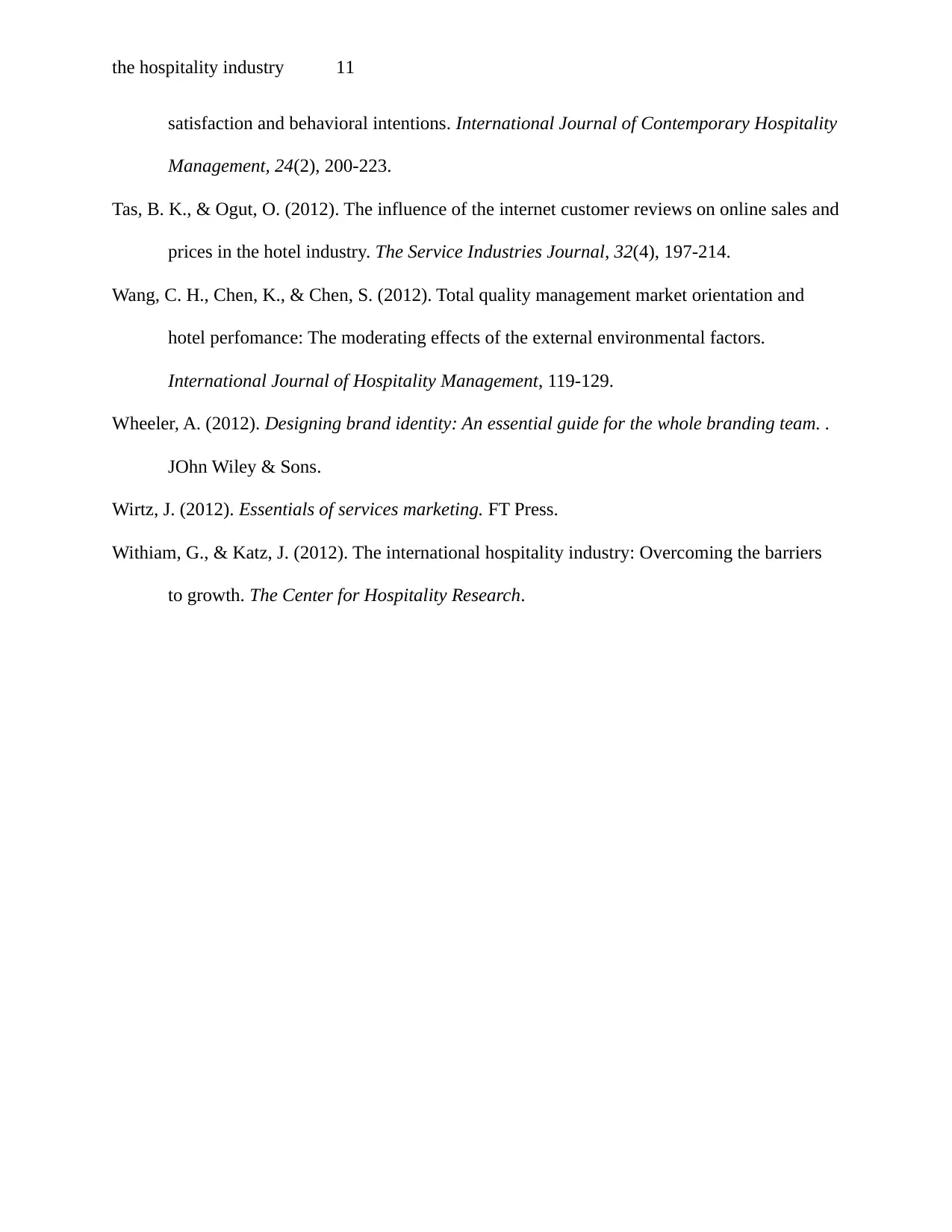
the hospitality industry 11
satisfaction and behavioral intentions. International Journal of Contemporary Hospitality
Management, 24(2), 200-223.
Tas, B. K., & Ogut, O. (2012). The influence of the internet customer reviews on online sales and
prices in the hotel industry. The Service Industries Journal, 32(4), 197-214.
Wang, C. H., Chen, K., & Chen, S. (2012). Total quality management market orientation and
hotel perfomance: The moderating effects of the external environmental factors.
International Journal of Hospitality Management, 119-129.
Wheeler, A. (2012). Designing brand identity: An essential guide for the whole branding team. .
JOhn Wiley & Sons.
Wirtz, J. (2012). Essentials of services marketing. FT Press.
Withiam, G., & Katz, J. (2012). The international hospitality industry: Overcoming the barriers
to growth. The Center for Hospitality Research.
satisfaction and behavioral intentions. International Journal of Contemporary Hospitality
Management, 24(2), 200-223.
Tas, B. K., & Ogut, O. (2012). The influence of the internet customer reviews on online sales and
prices in the hotel industry. The Service Industries Journal, 32(4), 197-214.
Wang, C. H., Chen, K., & Chen, S. (2012). Total quality management market orientation and
hotel perfomance: The moderating effects of the external environmental factors.
International Journal of Hospitality Management, 119-129.
Wheeler, A. (2012). Designing brand identity: An essential guide for the whole branding team. .
JOhn Wiley & Sons.
Wirtz, J. (2012). Essentials of services marketing. FT Press.
Withiam, G., & Katz, J. (2012). The international hospitality industry: Overcoming the barriers
to growth. The Center for Hospitality Research.
1 out of 11
Related Documents
Your All-in-One AI-Powered Toolkit for Academic Success.
+13062052269
info@desklib.com
Available 24*7 on WhatsApp / Email
![[object Object]](/_next/static/media/star-bottom.7253800d.svg)
Unlock your academic potential
© 2024 | Zucol Services PVT LTD | All rights reserved.





